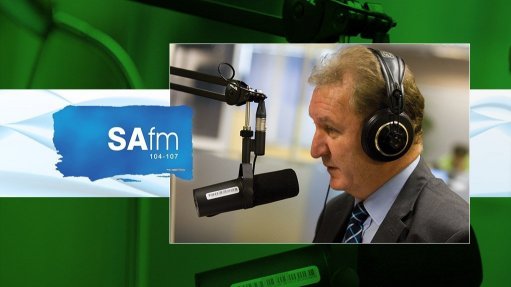Transnet’s recovery plan premised on securing govt capital injection
Absent an equity injection or debt relief from government, Transnet chairperson Andile Sangqu says the State-owned entity will not be able to deliver on what he described as a “credible” recovery plan for turning around the group’s dismal operational and financial performance.
The slump in the group’s performance is epitomised by the 77-million-ton collapse in rail volumes over the past six financial years, from 226-million tons railed in 2017/18 to only 149-million tons in 2022/23, as well as a decline in revenue over the period from R73-billion to R69-billion.
The group, which recently shed its CEO, CFO and rail head, reported a R5.7-billion loss last year and will also report a loss during the current financial year. Transnet has advertised the CEO position internally and externally, with a closing date of October 19.
Without being drawn on the specifics, Sangqu confirmed during a briefing that Transnet had approached both the National Treasury and the Department of Public Enterprises with various funding options but that it was the prerogative of the shareholder to decide on the nature and timing of any possible assistance.
Media reports indicate that Transnet has requested relief covering R61-billion of its R130-billion debt, as well as a R47-billion equity injection.
Finance Minister Enoch Godongwana is due to release the Medium-Term Budget Policy Statement on November 1 in a context of a fiscal position that is expected to have deteriorated since the February Budget, which included a R254-billion debt-relief package in favour of struggling State power utility Eskom.
Sangqu acknowledged that government had “many other constraints and that it will be a balancing act” if Transnet were also to be funded.
“What we have been able to present is a credible plan that we believe will be able to turn the fortunes of the company around and also restore confidence in the logistics sector,” Sangqu said, likening the request to those regularly made by private companies when in need of a capitalisation when asked whether Transnet was seeking a bail-out.
“So, we are really hoping that on the basis of the case that we have presented, we would be able to get the support from government.”
Acting CFO Hlengiwe Makhathini underlined this point, saying that the financial position would improve if volumes increased in line with the recovery plan’s targets, but that Transnet’s immediate financial constraints meant that it could not approach the market independently to fund the plan.
“We don't want to pre-empt how National Treasury will respond, but what we just want to emphasise is that, for our recovery plan to work, we do need government support in one way or the other.”
Transnet’s interest payments have climbed to R13-billion yearly and Makhathini described the monthly repayments of more than R1-billion as unsustainable.
Acting CEO Michelle Phillips reported that the recovery plan, which has been divided into 6-, 12- and 18-month periods, was premised primarily on a recovery of rail volumes from the 149-million tons reported last year to between 154-million tons and 170-million tons by the end of March next year.
She described the 170-million-tons goal as a “stretch target”.
In the six months to the end of September, volumes stood at 76-million tons, which means that the 78-million to 94-million-tons balance would have to be achieved in the second half, which was traditionally a period when lower rail volumes were recorded.
Given the weak financial position, rail and port operations will focus on the highest-margin traffic, while addressing starting to address a maintenance backlog estimated at R50-billion.
The recovery discounted any possible uplift that might be gained should a settlement be reached with CRRC of China, which stopped supplying parts and locomotives to Transnet after the contract was declared illegal.
A settlement agreement was nearly concluded last year but was thwarted by CRRC’s ongoing disputes with the South African Revenue Service and the South African Reserve Bank, which remain unresolved despite Ministerial level interventions from both countries. Therefore, CRRC locomotives formed a significant portion of some 377 locomotives that were currently out of service.
Phillips said the decision to exclude a CRRC settlement from the volumes in the recovery plan was based on the fact that the dispute remained outside of Transnet’s control.
The plan had been presented to the Ministers of Public Enterprises and Finance, but seemingly not to the members of the National Logistics Crisis Committee, or NLCC, which had been set up to address the freight logistics crisis and facilitate the introduction of reforms that would enable greater private sector participation (PSP).
Chief of strategy and planning Andrew Shaw indicated that the recovery plan was geared towards operations reforms, while the work being undertaken with the NLCC was prioritising structural reforms that were likely to take a longer to implement than the 18-month turnaround-plan timeframe.
However, Shaw stressed that there was a commitment to introduce third-party rail access during the recovery phase, which as a key structural reforms being overseen by the NLCC.
By the end of October, Transnet Freight Rail would be separate into operating and infrastructure business, known as Transnet Freight Rail Operating Company (TFROC) and Transnet Rail Infrastructure Manager (TRIM) respectively. In the interim, TFROC will be headed by Russell Baatjies and TRIM by Bessie Mabunda.
TRIM would focus on protecting and restoring rail network capacity for commercially viable high-volume traffic to assist TFROC in delivering the highest possible tonnage for each of the six-month components of the plan, Sangqu said.
He added that commercial and personnel separation would be complete by the end of October 2023 and that third-party access would be opened by April 2024.
Phillips stressed, however, that no privatisation was envisaged. Instead, PSPs would be pursued to unlock private capital, skills and operational best practice across the rail, ports, pipelines and engineering businesses.
As part of the recovery plan, Transnet would also be seeking permission to streamline procurement and a request for some deviations from prevailing procurement requirements and instruction notes had been submitted to the National Treasury.
The group would also pursue non-core assets sales, including the disposal property, scrap, and rolling stock.
Comments
Press Office
Announcements
What's On
Subscribe to improve your user experience...
Option 1 (equivalent of R125 a month):
Receive a weekly copy of Creamer Media's Engineering News & Mining Weekly magazine
(print copy for those in South Africa and e-magazine for those outside of South Africa)
Receive daily email newsletters
Access to full search results
Access archive of magazine back copies
Access to Projects in Progress
Access to ONE Research Report of your choice in PDF format
Option 2 (equivalent of R375 a month):
All benefits from Option 1
PLUS
Access to Creamer Media's Research Channel Africa for ALL Research Reports, in PDF format, on various industrial and mining sectors
including Electricity; Water; Energy Transition; Hydrogen; Roads, Rail and Ports; Coal; Gold; Platinum; Battery Metals; etc.
Already a subscriber?
Forgotten your password?
Receive weekly copy of Creamer Media's Engineering News & Mining Weekly magazine (print copy for those in South Africa and e-magazine for those outside of South Africa)
➕
Recieve daily email newsletters
➕
Access to full search results
➕
Access archive of magazine back copies
➕
Access to Projects in Progress
➕
Access to ONE Research Report of your choice in PDF format
RESEARCH CHANNEL AFRICA
R4500 (equivalent of R375 a month)
SUBSCRIBEAll benefits from Option 1
➕
Access to Creamer Media's Research Channel Africa for ALL Research Reports on various industrial and mining sectors, in PDF format, including on:
Electricity
➕
Water
➕
Energy Transition
➕
Hydrogen
➕
Roads, Rail and Ports
➕
Coal
➕
Gold
➕
Platinum
➕
Battery Metals
➕
etc.
Receive all benefits from Option 1 or Option 2 delivered to numerous people at your company
➕
Multiple User names and Passwords for simultaneous log-ins
➕
Intranet integration access to all in your organisation





















